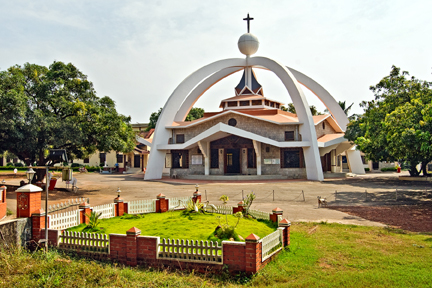|

The Infant
Jesus has been honored with a magnificent shrine at Carmel Hill,
Mangalore. The architectural structure and design of the newly
inaugurated shrine is unique in many ways. Carefully planned, it has a
rich symbolic meaning and significance derived principally from Biblical
themes, of both the old and the new testaments. Here below we give in
brief its main features.
The general Structure:
Five huge columns encircle and uphold the main structure, while
rising to a height nearly double that of the roof and converging under a
globe atop of which is planted a luminescent Cross. While at the base
the shrine is hexagonal, the roofing is pentagonal. The flooring is
generally of marble, except for the aisle and the border along the walls
which is granite. The wall itself is constructed of bare granite stones,
skillfully chiseled. The columns and ceiling are solid concrete as also
the overhead globe. The tubes for illumining the church are concealed;
their light is reflected and diffused by the ceiling.
Symbolism:
The basement surrounded by the five huge columns is intended to
represent the palm of the hand of God, in accordance with the text of
Isaiah, 'I have carved you on the palm of my hand'. And the five columns
represent the fingers of this Hand converging towards the overhead globe
which obviously symbolizes the universe. The Cross atop the globe is an
indication and symbol that God's love has redeemed all humanity through
Christ.
The Doors:
The Church may be entered by three doors, all of which are equally
'main' entrances: centre, right & left. The doors are all made of
seasoned teak wood, into which familiar Biblical themes are represented.
Over each of the doors too, part of the same theme is represented in 'krinklglas'.
Motifs:
On the door to the right of the centre, as one enters the Church the
krinklglas above represents God the Father giving the law on Sinai while
the door itself has a figure of Moses giving the law to the people.
Here, there is of the Christian assembly.
The door at the centre has a representation of the Nativity scene
whereas krinklglas above, pictures the Holy Spirit who overshadowed
Mary. Over the door, viz. the one to the left, the krinklglas pictures
the last trumpet to the final judgments. On the door itself Jesus is
depicted at Emmaus; breaking bread for His two disciples. The Holy
Sacrifice will be celebrated till the end of the world.
Flanking the doors:
Each of the doors is flanked by a grills with sketches of Carmelite
Saints wrought into them. The door to the right has a frame for St Elias
- the prophet - founder of the Carmelite Order and Blessed Mary of Jesus
Crucified - one of the foundresses of Mangalore Cloistered Carmel.
Flanking the Central door are representations of the two great Carmelite
reformers (also mystics and doctors of the Church) – Sts. Teresa of
Jesus and John of the Cross.
And the third door is flanked by grills wrought-in with images of the
'Little Rower' - Patroness of the missions and St Raphael Kalinowski - a
Polish Carmelite.
The Windows:
There are eight windows on the grills of each of which is depicted a
scene from the infancy of Jesus Annunciation, Visitation, Presentation,
Journey of the Magi, Flight into Egypt, Jesus in the Carpenter's shop,
the boy Jesus in the temple and the first miracle of Cana.
The ventilator grills above the windows contain scenes of the passion
and glorification of Jesus and Mary.
Circular Krinklglas Frames:
There are five circular krinklglas frames built into the centre of
the pentagonal structures supporting the roof. The central picture
represents the Risen Lord, while the four others have symbolic
representations of the four evangelists, in accordance with the book of
Revelation: the 'lion' for St. Mark, the 'man' for St. Mathew, the
'calf’ for St. Luke and the 'eagle' for St. John.
The Sanctuary:
The Attar: The frontispiece represents the hands of God, sustaining
the universe and the Cross marking the globe symbolizes the sacrifice
that is celebrated on the altar for universal redemption.
The Crucifix is not elevated above the ground but planted on the floor
of the Sanctuary to indicate 'God with us'. The image of the Crucified
is a carving, all of one piece of teak. To the right of the altar is the
Tabernacle and to the left is the Bible, symbolizing God's presence
among us, in word and sacrament respectively. The 'ambo' and the
tabernacle are cast in heavy metal, the latter displaying modern
artistic forms representing 'life and light'.
There are two niches, one on the right and one on the left, for the
statues of Our Lady of Mount Carmel and of the Infant Jesus
respectively.
As the 'star' guided the Magi to Jesus in Bethlehem, so may this shrine
draw people from East and West, North and South, over land and sea, to
the Savior and Creator of mankind.
|